Home » Jazz Articles » Multiple Reviews » Mick Rossi: Spontaneous Improvisation
Mick Rossi: Spontaneous Improvisation
True spontaneity is, however, virtually impossible since a player brings his or her total life up to that point, and what comes out is directly tied to what has happened before, and is the sum of all previous experiences. What pianist Mick Rossi, alone and with his friends and playing partners trumpeter Russ Johnson and saxophonist John O'Gallagher are trying to do is to play in the moment with no previous rehearsal and no known tunes, and then not fall back onto their own personal clichés, gimmicks or licks. This is extremely hard to do individually—and even more so with a partner—to create something coherent. The fact that the music moves, flows and develops is a tribute to the relationship that Rossi has with Johnson and O'Gallagher and the trust they have in each other. It takes extremely good ears and fast musical reflexes to make it work, as it does here.
The larger ensembles feature works are both examples of "loose" music that is a mix of the composed with the improvised, along with fast or sudden changes that keep everyone on their toes. The performers are given much room to add their own musical thoughts within the structure created by Rossi and which is minimally rehearsed to maintain the feel of spontaneity. Rossi's circle of musicians are so extremely competent and have become over time familiar with Rossi's technique that obvious blunders are just not heard. This compositional technique got carried out to the extreme at the recent MATA Festival, which Rossi guest curated and music-directed.
This music might be labeled as difficult because the musical rug has been pulled out from under the listener. Gone are standard chord changes, steady rhythmic patterns and melodies made up of easily recognized phrases. What is in its place is a sort of musical offering, something that really can never happen again, the paradox of the ephemeral captured.
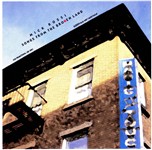 Mick Rossi
Mick Rossi
Songs From The Broken Land
Omnitone
Recorded 2005, Release late 2006
The title refers to the borough of New York City where Rossi lives—the word Brooklyn literally means "broken land" in Dutch (breukelen), and does have some other personal references. Instead of being created as an accident, Rossi actually set out to create a CD. In a sort of perverse, self-challenging way, he wanted to do a project of mostly free short pieces where he had absolutely no preparation before-hand.
Furthermore, he literally wanted to record after not having touched the instrument for a couple of weeks, let alone have practiced. Since he had been on tour with minimalist composer Philip Glass for quite a while, when he got back he set up to record and jumped in, being more interested in the spontaneity of it than in technical niceties. Rossi did plan, however, to do one old American song, and decided in the moment to do six Stephen Foster variations for prepared piano. He also wanted to include a spontaneous arrangement/improvisation on a piece originally written for solo viola by the excellent guitarist/composer Johnnie Valentino, "Solfegietto," as well as an original tune called "Cante Jondo."
Thus the Stephen Foster variations form a sort of backbone for the record. They differ not only in the way the melody is played, but in the preparation, where the range of prepared notes differs. The other pieces are totally improvised, some also with piano preparation. They vary widely stylistically, including fugal sections, gnarly twelve-tone sounding lines, impressionistic Debussy-ish harmonies (which sound at times like "The Sunken Cathedral"), much that sounds Romantic or even Post-Romantic classical, and some amazing technical displays ("VLA").
The most intriguing thing, however, is the degree to which this more or less spontaneous music actually works, how a cadence can appear out of nowhere, or a piece can end suddenly, both of which mean that expectations have been created. To feel these kind of things means that the music is not random, but has an internal cohesion that can be sensed if not immediately understood. Rossi purposefully sets the stage in such a way as to minimize the familiar, even his technique. If jazz is music created in the moment, and here we have, in the totally spontaneous pieces, no familiar ground such as a tune to improvise upon, then this effort must qualify as "truer than true" jazz. What you hear is Rossi the person expressed as music—artful communication at its best.
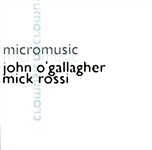 Mick Rossi/John O'Gallagher
Mick Rossi/John O'Gallagher
micromusic - twenty unfinished works
Self-Published
Recorded 2005, contact Omnitone for availability
Unlike New Math, micromusic was set up as something to be recorded from the start, but also with very little preparation. However, Rossi has such high regard for O'Gallagher's facility and quicksilver musical reflexes (see Rules of Invisibility Volume I and Volume II), that he hoped he would bring instruments other than his alto and soprano saxophones on which he is so facile. O'Gallagher obliged and brought C-melody and toy saxophones along with some wood flutes.
Rossi and O'Gallagher state that micromusic "contains 'pieces' of pieces—i.e. mostly concise, intentionally 'unfinished' works. The only mandate was to immerse each song in irony and incompleteness." The "small," "smaller" and "smallest" groupings do not really mean very much since they originally referred to the tracks' lengths, and then the tracks got reordered. The structure of the record that is left is eighteen fairly short musical interactions—the unknown and the random—interrupted by arrangements of rather well known tunes in the middle ("Stairway to Heaven," by Led Zeppelin) and at the end ("Had To Cry Today," by Blind Faith).
Since this was an arranged meeting of musical minds, one must assume that everything about the project has a purpose. To be sure, the irony is very strong in the arrangements of the known tunes. Both manage to be very serious and very funny at the same time, both in and of themselves and the fact that they provide relief in the form of the recognizable after so much which is totally new and of harder to hear structure, and also in the very subversion of the recognized melody.
The wholly original pieces have various amounts of intensity as Rossi and O'Gallagher lead and follow each other. "Small 1" consists of a fast twisting line and is over before one can settle in. "Small 2" is actually quite romantic, with an impressionistic harmony and a line made up of a repeated figure, ending on a haunting held sax note. "Small 3" uses the Rossi technique of repeated muted notes and sounds like the sax is musically frustrated in trying interrupt the piano or to interject something. "Smaller 6" sounds a bit like "Small 2" at first, but the prepared piano spans a wider range. The piano picks up the sax note via harmonic excitation. The rhythm doubles occasionally and the sax writhes around the static harmony until a surprise cadential ending appears.
"Smaller 7" is harmonically clearly defined by beautiful piano chords as the saxophone keeps playing outside long enough to create humor and tension, ending in another cadence. "Smallest 15" features lines that could come from Greg Osby played against walking piano bass notes that do not swing, and a high note counter line. "Smallest 16" is arguably the most beautiful track that contains the purest saxophone sounds against a floating harmonic base from the piano.
Much of this music is abstractly pure, having no clear mental resting points for the listener, and yet it is many times mesmerizing, as well as unpredictable between tracks. micromusic is very easy to recommend for its surface beauty as well as the complexity that unfolds with repeated listens.
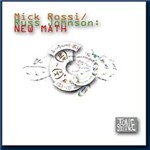 Mick Rossi/Russ Johnson
Mick Rossi/Russ Johnson
New Math
Tone Science
2003
New Math was not supposed to be an album. Johnson (see Save Big) went over to Rossi's place to "just play," Rossi had some microphones and they let the recorder roll. Only afterward, when they had listened to what had transpired, did they decide to turn it into a CD. Johnson is well known for the many different sounds he can get out of his trumpet and with Rossi, one never knows what is going to come out of his fingers.
What is fascinating is that Johnson can see what Rossi is physically doing (if he needs to), while Rossi has to just be able to hear what Johnson is playing and react accordingly. Rossi and Johnson do know each other very well and that translates into almost knowing what the other is going to do before it happens.
Improvising within a known structure is hard enough, but playing without a net and somehow producing vigorous, flowing, coherent music is something to applaud. Being a fly on the wall, and listening in real time to two master musicians lead and follow, create and respond, push and pull, is fascinating and well worth the extra effort to stay with the ever-changing structure and feel. One can wonder at the paradox of spontaneous prepared piano!
The track titles mean nothing but refer to something about the recording process. Using words to describe music is always difficult, and with this kind of totally improvised music the words can devolve into mere description. In "2.70," note how what happens next depends on what just happened and creates a flow. This first track introduces the process and, since it is the longest piece by far, in many ways it is a compendium of the kind of things that end up making a coherent piece of spontaneous music.
The trumpet begins playing and the piano responds with a plucked matching note. A Rossi gesture that shows up more than once, a repeated prepared single note that speeds up and slows down is played. Things seem to go up a step and the trumpet expands his range, introducing a little bluesiness. The piano plays some Bartokian lines and suddenly the piece feels tonal! A romantic gesture is played by Rossi and some counterpoint with the trumpet is set up ending in the repeated figure, but followed by lush chords that feint a cadence. Rossi then sounds like he is summarizing the whole proceedings connected by the repeated figure and the piece ends with sucking trumpet sounds against a sparse piano line.
Other pieces have much romanticism ("2.90") or impressionism ("1.10") or both ("1.50") and feel very organic in that the logic of what happens can be discerned, perhaps after the fact, despite the unpredictability in the moment. Textures and rhythms can change quickly and Johnson can produce many sounds from his horn. Johnson leads as often as he follows. Indeed, in the last (untitled) track, he starts of with the theme from the "Art Of The Fugue" modified a bit and Rossi picks it up leading to a chorale-like section that is classically beautiful. Johnson responds with a gorgeous line and Rossi answers with low, dense harmony. Maybe the choice of theme was meant to emulate the summarization that Bach was stating about fugues in the Baroque era, but who knows?
A live performance of this kind of music might very well totally engross the audience as they watch and listen as Rossi and Johnson create structures out of nothing except cause and effect, and which only in retrospect can be said to have worked or not.
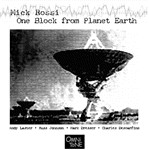 Mick Rossi
Mick Rossi
One Block From Planet Earth
Omnitone
2002
Recorded live in one take at the Knitting Factory, this complex music was rehearsed but once. Rossi likes the idea of not allowing the musicians to become familiar with the music's structure, which might change at the next moment. An interesting aside to the making of this record is that Andy Laster was sick for the only rehearsal and John O'Gallagher (whom we met above in micromusic) filled in and played the rehearsal for him that day. So now you have someone sight-reading the music so that the band can get the true feel for how it sounds during rehearsal, only to have the real performer sight-read the music during the actual performance! Having been able to see the actual music to "Page X," I can vouch for the extremely high degree of proficiency that everyone involved has attained. Rossi, in this music and They Have A Word For Everything, likes to combine his classical training and attitude to challenge listeners by mixing precise notation, exactly or loosely played (meaning with the feeling of improvisation; see Ellington), and pure improvisation, sometimes all going on at the same time. He also likes to incorporate sudden shifts in texture or feel so as to force the performers to possibly lose their footing for a moment and then really improvise!
Rossi, although he does not like the downtown label, produces music that is full of nuance and detail and which challenges convention, thereby forcing listeners off balance and perhaps even questioning their own preconceptions. Opposing this desire, however, is the paradox of an audience or listener who searches out this music precisely because of its unpredictability, thus expecting nothing and revelling in the music's continuous self-negations.
The pieces were conceived as a performance suite and thus order is important. Individually, most of the pieces have a very loose ABA structure whereby a motive, fragment or melody is introduced in whole or part, then explicitly developed or used as a jumping-off point for the contrasting B section, and finally a return is heard in some manner. The idea of a circular journey, even with as many side trips as can be taken with this music, is comforting and fullfilling.
The music really must be experienced directly, but some highlights will help elucidate Rossi's methods. "Page X" has many humorous parts, including the saxophone solo, which is on the blues progression, but with a Spanish tinge, the feel of which was introduced in fits and starts at the beginning of the piece. Before this, Johnson had let loose with a flying solo on a static harmony over a Spanish sounding scale, which he duly subverts, of course. "I Gotta Go To Bed" starts off with a unison trumpet and sax line that has wide intervals. Bass and drums come in, but in what appears to be an altogether different meter. Piano adds adds rapid chromatic lines as the bass gets more active until a funky syncopated vamp emerges!
The sound is fantastic, but it does not last. The vamp keeps trying to arise but keeps getting interrupted by calm sections that manage to sound ominous at the same time. Rossi's gnarly, chromatic lines get denser and denser until the vamp returns and the piece ends without explicitly returning to the A section. "Changed" begins with an arco bass solo that uses harmonics, double stops and dissonances and which has a distinct classical feel. Eventually, the band enters as a sort of response. A definite rhythm develops and a three-note figure becomes a motive that is taken up by the band. There is a pulse, but it is not obvious until a funky rhythm develops out of nowhere from a piano solo, complete with horn interjections, and now the groove is quite deep.
The audience applauds loudly and cheers when this mini-suite, made up of eight musical mini-dramas, is over. This recording, which cannot really substitute for having been there, allows everyone to experience Rossi's (along with his band mate's) musical odyssey. Come along, and maybe hang on, for the ride.
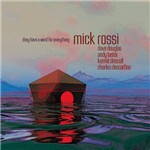 Mick Rossi
Mick Rossi
They Have A Word For Everything
Knitting Factory
1999
This record is very much a studio version of One Block From Planet Earth recorded three years earlier. The Rossi compositional methodology is the same: individual pieces that create their own rules and universe during their performance. The movement from piece to piece is determined by the flow desired of the larger whole. Internally, most of the pieces have a theme which is developed, and a loose ABA structure. Sections can have sharp contrasts either in instrumentation or style or rhythm, sometimes specifically to keep the players on their toes, again with little rehearsal, and again the musicianship of his circle is so high that it all seems effortless. As in One Block, the pieces contain a mix of the composed and the improvised, with the composed music either strictly or loosely played.
As one becomes familiar with Rossi's music, its nuances become more apparent, the layers start to reveal themselves and the shock of always changing becomes less disconcerting and almost more expected. It eventually becomes accepted as a style. Because each piece is so different, there is little chance of being bored over the course of a CD, but also within a piece the always-changing mood and feel keeps one's ears on their toes, so to speak.
Getting specific, "They Have a Word for Everything" is conventionally beautiful in a smoky, late-night, mysterious way, with the drums using brushes and the harmony oscillating between I7 and IV7, touching on the blues in a "'Round Midnight" kind of way. "Shadow of a Thrush" and "I Stop There" are good examples of a theme or motive being developed in different ways to give each a coherence. "Camus" shows Rossi's use of sudden changes and contrasts which are always fun to feel, even when they are expected, while "Space Junk" has a chaotic sounding beginning which evolves into some of the coolest, most driving music on the record.
The bottom line is that Rossi's music is really not difficult. It is never assaultive, but can be quite dissonant; it can be diffuse and complex, but always has something to hold it together, to give the pieces form. Rossi's musical mind is fun to be around and he is serious without taking himself too seriously. Plus, his musical circle seems to truly enjoy playing his music and Rossi's catholic tastes, where a deep blues can suddenly surface from the most arcane, arrhythmic twelve-tone free music.
Tracks and Personnel
Songs From The Broken Land
Tracks: My Old Kentucky Home (Variation 1); Dog Smiles; Sans Jour; The Master and Margherita; My Old Kentucky Home (Variation 2); Ghost Girl; Critical Mass; One Leaning Against The Next; Without; Monkeys With Hats; My Old Kentucky Home (Variation 3); Mind Field; Rods and Cones; VLA; Temporal Shift; Sonar; Dine; Cante Jondo; My Old Kentucky Home (Variation 4); Solfegietto; My Old Kentucky Home (Variation 5); Go; Not No; My Old Kentucky Home (Variation 6).
Personnel: Mick Rossi: piano, prepared piano.
micromusic
Tracks: small: 1-5; smaller: 6-10; Stairway to Heaven; smallest: 12-19; Had To Cry Today.
Personnel: Mick Rossi: piano, prepared piano; percussion; John O'Gallagher: alto saxophone, soprano saxophone; c-melody saxophone; toy saxophone; wood flutes; percussion.
New Math
Tracks: _2.70; _3.30; _2.90; _1.91; _1.10; _1.22; _1.50; _2.20; _1.13; unlisted track #1; unlisted track #2.
Personnel: Mick Rossi: piano, prepared piano; Russ Johnson: trumpet.
One Block from Planet Earth
Tracks: Page X; Henry and Ribsy; I Gotta Go to Bed; Through Lesser Things; Biohazard; Stasis; Changed; Whatever.
Personnel: Mick Rossi: piano; Andy Laster: clarinet, alto and baritone saxophone; Russ Johnson: trumpet; Mark Dresser: bass; Charles Descarfino: drums, percussion.
They Have A Word For Everything
Tracks: Camus; Space-Junk; As If; Translator; Haus; Whatever; A Stubborn Thereness; They Have A Word For Everything; Don't Call Me There; Collision; Shadow Of A Thrush; I Stop There.
Personnel: Mick Rossi: piano, glockenspiel; Dave Douglas: trumpet; Andy Laster: alto and baritone saxophone; Kerit Driscoll: double-bass; Charles Descarfino: drums, percussion.
< Previous
Choros y Alegria
Comments
Tags
For the Love of Jazz
 All About Jazz has been a pillar of jazz since 1995, championing it as an art form and, more importantly, supporting the musicians who create it. Our enduring commitment has made "AAJ" one of the most culturally important websites of its kind, read by hundreds of thousands of fans, musicians and industry figures every month.
All About Jazz has been a pillar of jazz since 1995, championing it as an art form and, more importantly, supporting the musicians who create it. Our enduring commitment has made "AAJ" one of the most culturally important websites of its kind, read by hundreds of thousands of fans, musicians and industry figures every month.



















